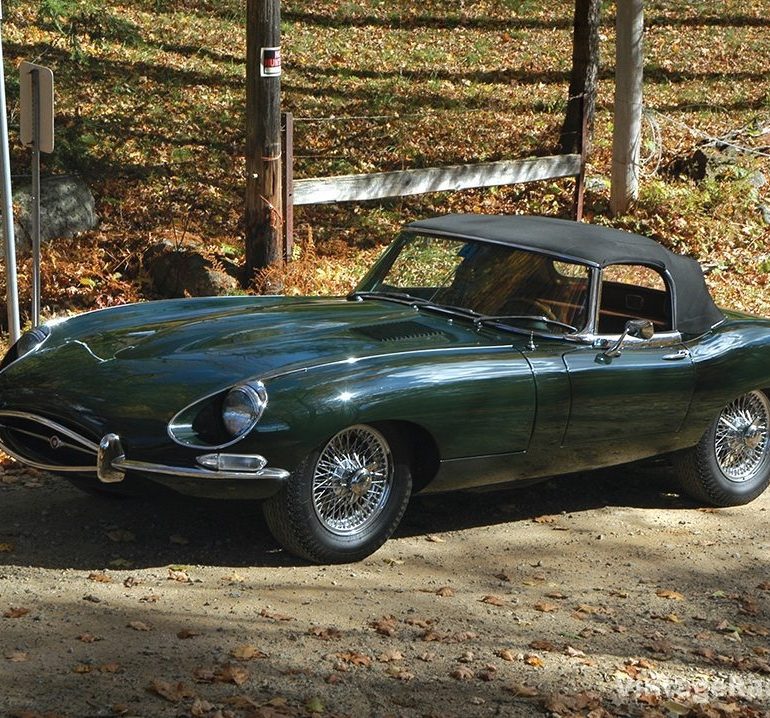Not too long ago, a very good friend called me about his 1967 4.2 Jaguar XKE OTS. He had two precise questions for me to research and a task. First, was his XKE a Series 1 or Series 1.5? Second, was his car originally equipped with an enclosed headlight bonnet or open headlight bonnet? Finally, would I research the provenance of his XKE.
I started my research, as I always do where appropriate, and checked the car’s VIN number to see if it has ever been reported lost or stolen. I use the National Insurance Crime Bureau (NICB) website, which provides a number of free searches each month. My search indicated this XKE has never been reported as stolen or totaled. www.nicb.org/theft_and_fraud_awareness/vincheck/vincheck
There are many good resources for Jaguar XKE research, books by Paul Skilleter, Philip Porter and Dr. Thomas Haddock, to name but a few. All are great, but Dr. Haddock’s book pulls all resources together, so that is the one I referred to. Dr. Haddock’s book, “Jaguar E-Type 6 & 12 Cylinder Restoration Guide,” is an incredibly detailed examination of the E-Type. His research is meticulous and the photographs, all from unmodified original cars, are plentiful to say the least.
I also referred to XK Data online and the Jaguar Club of North America Concours Judging guide for the Series 1 XKE. http://www.xkedata.com. Finally, I contacted Michael L. Cook, Jaguar Cars Archivist to acquire a Jaguar Heritage Certificate for this XKE. This certificate provides a lot of build information, as well as the name of the first owner of the car and their city and state, at the time of purchase.
The Heritage Certificate stated that this XKE, Serial #1E15620, was built on May 11, 1967 and delivered to Jaguar Cars in New York on July 6, 1967. The Heritage Certificate also provided the name of the first buyer and his location. This will be important later.
August was the model year changeover month at Jaguar. XKEs built in August of 1967 and on were considered and sold as 1968 model year XKEs. Since our subject car was built in May of 1967, we know for certain it was a 1967 model. Now, is it a Series 1 or Series 1.5?
As many readers will know, Jaguar Cars has never identified any of the XKEs as Series 1, Series 1.5, Series 2 or Series 3. Car collectors and Jaguar enthusiasts have used these designations to identify changes in specifications, but not Jaguar Cars themselves. No reference to Series 1, 2 or 3 ever appeared in sales brochures, repair manuals or parts listings.
For the sake of simplicity, I suggest we continue with the Series 1, 1.5, 2 and 3 designations. If we do, then the following years apply for XKE production: 1961–1967 Series 1; 1968 Series 1.5; 1969–1971 Series 2; 1971–1974 Series 3.
Dr. Haddock agrees with the serial number database provided by Skilleter. This database indicates that the Series 1 serial numbers for a left-hand drive, open two-seater start with 1E10001 and run until 1E15888. The Series 1.5 cars start with serial number 1E 15888 for a left-hand-drive, open two-seater. Clearly our subject XKE, serial number 1E15620, is close and on the cusp, but still very much a Series 1.
Now, since we know this car is a Series 1, what of the question of open or closed headlights? Jaguar Build records and Jaguar Spares records do not agree as to when the enclosed headlights were discontinued. Both records are quoted below. The source of this information was both the Haddock book and JCNA Series 1 E type Judge’s Guide.
• Jaguar Build records Glass covers deleted at: Left-hand drive, OTS serial number 1E 14535.
• Jaguar Spares Bulletin (P198-Canada and USA only) Glass covers deleted at: Left-hand drive, OTS serial number 1E 14532
Regardless of which record you use it is apparent that the glass headlight covers were deleted before our subject car was built.
Now, on to provenance. A serendipitous find made the provenance of this car absurdly easy to research. I had the current owner’s name and I had the first owner’s name, as it appeared on the Heritage Certificate. The remaining task was to fill in all the past owners.
The current owner was a bit of a hoarder. He kept referring to a plastic crate he had in his possession filled with all sorts of “paper work.” When I received the crate I found it was full of restoration photos, repair receipts going back to when the car was new, old titles, release of lien documents for car loans, names and addresses of past owners and registration documents. A veritable treasure trove and a reminder to us all not to throw away any documents. A beautiful car with full documentation will quickly surpass the value of a undocumented car with more questions than answers.
At this point it is important to note two things. First, provenance research is not static. New information is always coming forward. Two, provenance alone does not authenticate a car. It is but a third of the equation. The other two requirements for authentication are an
examination by an expert, and scientific testing where necessary.
In this case with a little time and uncommonly good luck I was able to complete all three tasks asked of me by this owner. He sold this car at a fantastic price last October to the first person who looked at it. A
beautiful, desirable car with full documentation and provenance can be very compelling.
Jeff Murray researches provenance for all makes. Visit his website at www.vintagecarresearch.com to learn more.




